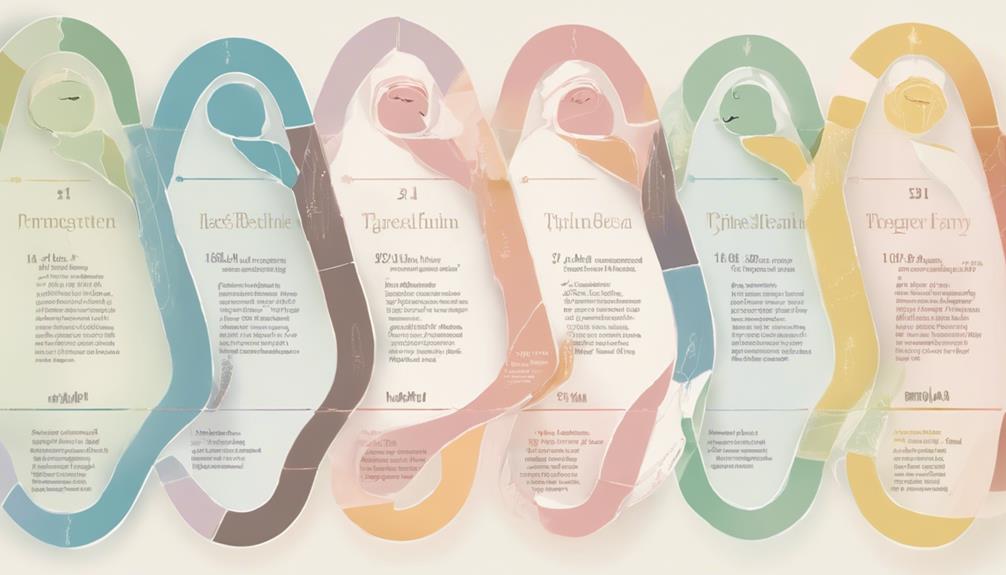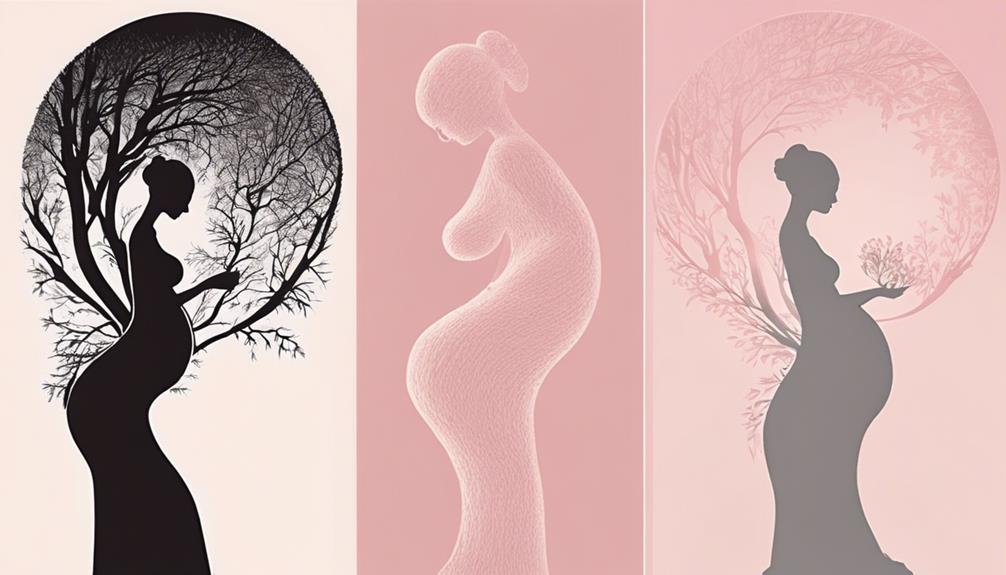During the progression of pregnancy, the second trimester blossoms like a flower, revealing new facets of this remarkable journey.
But have you ever wondered, how many months does this pivotal phase actually encompass?
Let's explore the intricacies of the second trimester and unravel the mysteries that lie within.
Key Takeaways
- Second trimester spans from week 14 to around week 27, totaling 14 weeks.
- Key fetal development occurs, including facial features, organ formation, and limb growth.
- Maternal body experiences significant changes like uterus expansion, skin stretching, and weight gain.
- Emotional well-being is crucial, balancing excitement with occasional anxieties, monitoring for antenatal depression signs.
Duration of the Second Trimester
The second trimester of pregnancy typically spans a duration of approximately 14 weeks, starting at week 14 and concluding around week 27. During this phase, which encompasses months 4, 5, and 6 of pregnancy, significant fetal development occurs.
By the end of the second trimester, around the 24th week, the fetus has grown rapidly, and important organs have started to form. This period marks a critical time for monitoring fetal growth, preparing for childbirth, and addressing any emerging health concerns.
As the second trimester progresses, healthcare providers closely monitor the baby's development through regular check-ups and ultrasound scans to make everything is progressing as expected. Expectant parents also start preparing for the arrival of their little one by attending childbirth classes, setting up the nursery, and discussing birthing preferences with their healthcare team.
This phase is a time of anticipation and preparation as they near the final trimester of pregnancy.
Milestones in the Second Trimester

Moving forward from the development of facial features and organ formation in the second trimester, a notable milestone during this period is the onset of quickening, which signifies the first recognizable fetal movements experienced by expectant mothers.
As the weeks progress, the fetus continues to grow and develop, with the formation of fingers and toes becoming more defined. By the fourth month, the tiny being inside the womb already has eyelids, eyebrows, eyelashes, nails, and hair. These developments mark significant steps towards a fully formed baby.
Additionally, during this stage, the fetus can be observed making faces, stretching its limbs, and may even be seen sucking its thumb on ultrasounds. Towards the end of the second trimester, hearing development begins, allowing the fetus to start responding to external sounds.
These milestones not only signify the incredible growth happening within the womb but also provide expectant parents with glimpses into the miraculous journey of fetal development.
Physical Changes in the Second Trimester
Throughout the second trimester of pregnancy, expectant individuals experience significant physical changes as their body adapts to accommodate the growing baby. The uterus undergoes remarkable growth to provide ample space for the developing baby, resulting in a noticeable increase in belly size. This expansion can cause skin stretching, leading to itchiness and the formation of stretch marks on various body parts. Additionally, there's an increase in blood volume to support the baby's circulation needs, contributing to weight gain during this phase.
Expectant individuals may also notice breast enlargement as their body prepares for lactation after the baby's arrival. These physical transformations, although natural and essential for a healthy pregnancy, can sometimes bring discomfort. It's important to stay hydrated, moisturize the skin regularly, and wear comfortable clothing to ease the effects of these changes. Embracing these physical adjustments is an important part of the miraculous journey of nurturing and growing a new life within.
Emotional Well-being in the Second Trimester

Emotional well-being in the second trimester of pregnancy involves understanding the mix of excitement and occasional anxiety that expecting parents may experience. While this period is often marked by anticipation and joy, worries about childbirth, parenting, and the future may surface, leading to emotional challenges. Persistent feelings of anxiety or low mood could be signs of antenatal depression, a condition that shouldn't be ignored. Prioritizing emotional well-being during the second trimester plays an important role in overall maternal health.
Seeking help from healthcare professionals or support hotlines is encouraged for individuals facing emotional difficulties. These resources can provide valuable support and guidance to navigate the complexities of the second trimester. Remember, it's okay to seek help and prioritize your emotional well-being during this time. By addressing emotional challenges proactively, you can better enjoy this stage of pregnancy and set the foundation for a healthier postpartum period.
Baby Development in the Second Trimester
Entering the second trimester, a significant focus shifts to the remarkable baby development and fetal growth in the womb. During this stage, the baby undergoes substantial growth, increasing from about 7.5cm and 30g to around 23cm and 820g. One of the exciting developmental milestones during the second trimester is the baby's noticeable movements, which typically begin around week 19, bringing a sense of connection for expecting parents.
Additionally, essential organs like the liver, pancreas, and kidneys start functioning during this period, paving the way for a healthy life outside the womb. Ultrasounds play a vital role in monitoring the baby's growth and development, providing valuable insights into the baby's progress. To ensure everything is progressing as it should, regular antenatal visits every 4 to 6 weeks are recommended to track the baby's movements and overall well-being.
The second trimester is a time of significant baby growth and development, and staying informed about these changes can help parents feel more connected to their little one.
Frequently Asked Questions
How Many Months Are You in Your Second Trimester?
We are typically 4 to 6 months pregnant during the second trimester, which spans weeks 14 to 27. This period is important for fetal growth and development. Monitoring it closely guarantees proper care for both baby and me.
How Long Is the 2nd Trimester?
We're in the second trimester of pregnancy for about 14 weeks from week 14 to 27. It's a time of reduced symptoms and critical fetal growth. This phase is often seen as the most comfortable and enjoyable.
Is 2nd Trimester 13 or 14 Weeks?
In our experience, the second trimester often begins around week 13, with some including week 13 as part of it. Healthcare providers may simplify and start at week 14. This trimester generally lasts until week 26 or 27.
How Many Weeks Is 9 Months Pregnant?
We're in the loop, 9 months pregnant spans about 36 to 40 weeks. The journey's end is near, and the anticipation grows. It's a time of wonder, patience, and readiness for the new chapter ahead.
Conclusion
As we journey through the second trimester of pregnancy, we witness the remarkable growth and development of our baby. Significant changes in our own bodies and emotions accompany this stage. It's a time of anticipation and preparation, filled with milestones and challenges. These experiences ultimately bring us closer to the miracle of childbirth.
Let's embrace this transformative journey with gratitude and readiness for what lies ahead.









